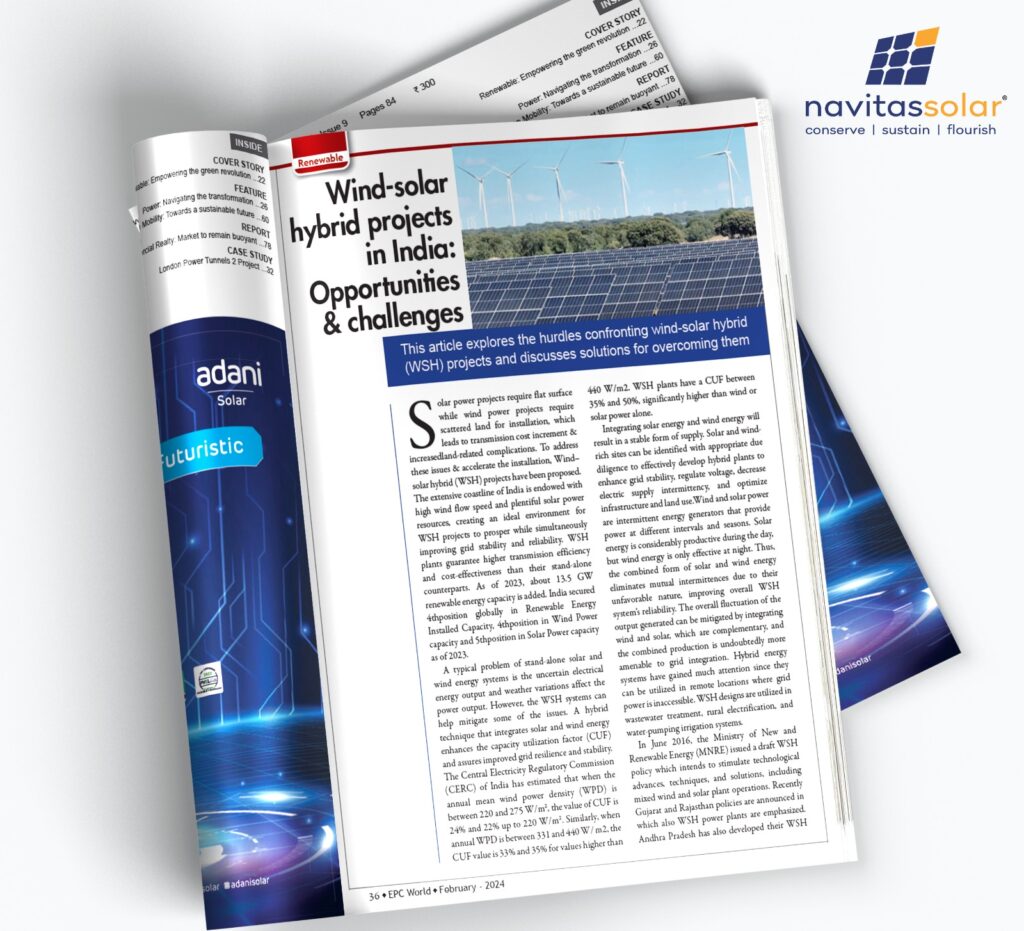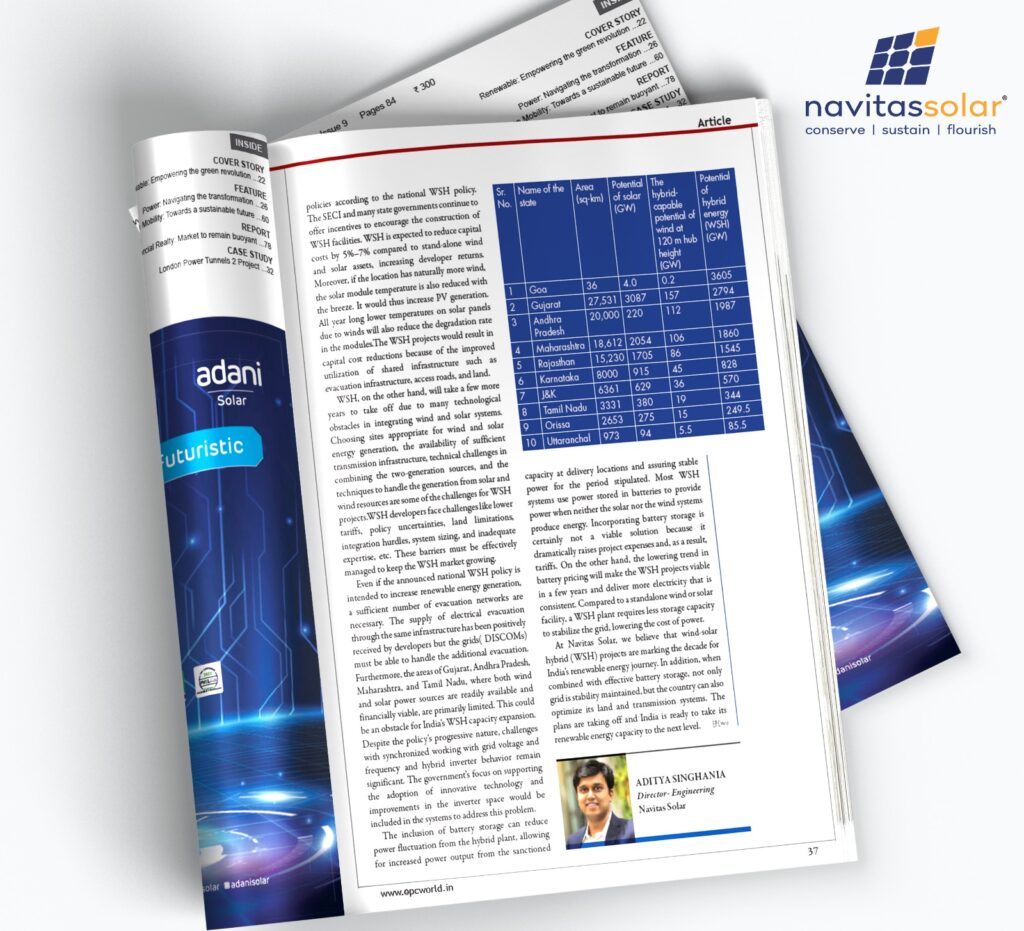Wind Solar Hybrid (WSH) Projects in India: Opportunities & Challenges


Solar power projects require flat surface while wind power projects require scattered land for installation, which leads to transmission cost increment & increased land-related complications. To address these issues & accelerate the installation, Wind–solar hybrid (WSH) projects have been proposed. The extensive coastline of India is endowed with high wind flow speed and plentiful solar power resources, creating an ideal environment for WSH projects to prosper while simultaneously improving grid stability and reliability. WSH plants guarantee higher transmission efficiency and cost-effectiveness than their stand-alone counterparts. As of 2023, About 13.5 GW renewable energy capacity is added. India secured 4th position globally in Renewable Energy Installed Capacity, 4th position in Wind Power capacity and 5th position in Solar Power capacity as of 2023.
A typical problem of stand-alone solar and wind energy systems is the uncertain electrical energy output and weather variations affect the power output. However, the WSH systems can help mitigate some of the issues. A hybrid technique that integrates solar and wind energy enhances the capacity utilization factor (CUF) and assures improved grid resilience and stability. The Central Electricity Regulatory Commission (CERC) of India has estimated that when the annual mean wind power density (WPD) is between 220 and 275 W/m2, the value of CUF is 24% and 22% up to 220 W/m2. Similarly, when annual WPD is between 331 and 440 W/ m2, the CUF value is 33% and 35% for values higher than 440 W/m2. WSH plants have a CUF between 35% and 50%, significantly higher than wind or solar power alone.
Integrating solar energy and wind energy will result in a stable form of supply. Solar and wind-rich sites can be identified with appropriate due diligence to effectively develop hybrid plants to enhance grid stability, regulate voltage, decrease electric supply intermittency, and optimize infrastructure and land use. Wind and solar power are intermittent energy generators that provide power at different intervals and seasons. Solar energy is considerably productive during the day, but wind energy is only effective at night. Thus, the combined form of solar and wind energy eliminates mutual intermittences due to their unfavorable nature, improving overall WSH system’s reliability. The overall fluctuation of the output generated can be mitigated by integrating wind and solar, which are complementary, and the combined production is undoubtedly more amenable to grid integration. Hybrid energy systems have gained much attention since they can be utilized in remote locations where grid power is inaccessible. WSH designs are utilized in wastewater treatment, rural electrification, and water-pumping irrigation systems.
In June 2016, the Ministry of New and Renewable Energy (MNRE) issued a draft WSH policy which intends to stimulate technological advances, techniques, and solutions, including mixed wind and solar plant operations. Recently Gujarat and Rajasthan policies are announced in which also WSH power plants are emphasized. Andhra Pradesh has also developed their WSH policies according to the national WSH policy. The SECI and many state governments continue to offer incentives to encourage the construction of WSH facilities. WSH is expected to reduce capital costs by 5%–7% compared to stand-alone wind and solar assets, increasing developer returns. Moreover, if the location has naturally more wind, the solar module temperature is also reduced with the breeze. It would thus increase PV generation. All year long lower temperatures on solar panels due to winds will also reduce the degradation rate in the modules. The WSH projects would result in capital cost reductions because of the improved utilization of shared infrastructure such as evacuation infrastructure, access roads, and land.
WSH, on the other hand, will take a few more years to take off due to many technological obstacles in integrating wind and solar systems. Choosing sites appropriate for wind and solar energy generation, the availability of sufficient transmission infrastructure, technical challenges in combining the two-generation sources, and the techniques to handle the generation from solar and wind resources are some of the challenges for WSH projects. WSH developers face challenges like lower tariffs, policy uncertainties, land limitations, integration hurdles, system sizing, and inadequate expertise etc. These barriers must be effectively managed to keep the WSH market growing.
Even if the announced national WSH policy is intended to increase renewable energy generation, a sufficient number of evacuation networks are necessary. The supply of electrical evacuation through the same infrastructure has been positively received by developers but the grids ( DISCOMs) must be able to handle the additional evacuation. Furthermore, the areas of Gujarat, Andhra Pradesh, Maharashtra, and Tamil Nadu, where both wind and solar power sources are readily available and financially viable, are primarily limited. This could be an obstacle for India’s WSH capacity expansion. Despite the policy’s progressive nature, challenges with synchronized working with grid voltage and frequency and hybrid inverter behavior remain significant. The government’s focus on supporting the adoption of innovative technology and improvements in the inverter space would be included in the systems to address this problem.
State wise WSH potential is shown in the table below:
| Sr. No. | Name of the state | Area (sq-km) | Potential of solar (GW) | The hybrid-capable potential of wind at 120 m hub height (GW) | Potential of hybrid energy (WSH) (GW) |
|---|---|---|---|---|---|
| 1 | Goa | 36 | 4.0 | 0.2 | 3605 |
| 2 | Gujarat | 27,531 | 3087 | 157 | 2794 |
| 3 | Andhra Pradesh | 20,000 | 220 | 112 | 1987 |
| 4 | Maharashtra | 18,612 | 2054 | 106 | 1860 |
| 5 | Rajasthan | 15,230 | 1705 | 86 | 1545 |
| 6 | Karnataka | 8000 | 915 | 45 | 828 |
| 7 | J&K | 6361 | 629 | 36 | 570 |
| 8 | Tamil Nadu | 3331 | 380 | 19 | 344 |
| 9 | Orissa | 2653 | 275 | 15 | 249.5 |
| 10 | Uttaranchal | 973 | 94 | 5.5 | 85.5 |
The inclusion of battery storage can reduce power fluctuation from the hybrid plant, allowing for increased power output from the sanctioned capacity at delivery locations and assuring stable power for the period stipulated. Most WSH systems use power stored in batteries to provide power when neither the solar nor the wind systems produce energy. Incorporating battery storage is certainly not a viable solution because it dramatically raises project expenses and, as a result, tariffs. On the other hand, the lowering trend in battery pricing will make the WSH projects viable in a few years and deliver more electricity that is consistent. Compared to a standalone wind or solar facility, a WSH plant requires less storage capacity to stabilize the grid, lowering the cost of power.
At Navitas Solar, we believe that wind-solar hybrid (WSH) projects are marking the decade for India’s renewable energy journey. In addition, when combined with effective battery storage, not only grid is stability maintained, but the country can also optimize its land and transmission systems. The plans are taking off and India is ready to take its renewable energy capacity to the next level.


Related Posts
You May Also Like
A Step-by-Step Guide to Solar…
Read MoreEmpowering the Leaders of Tomorrow:…
Read MoreThe Future of Energy is…
Read MoreNavitas Solar Powers Up for…
Read MoreRCB Goes Green: How Navitas…
Read MoreThe Green Revolution in Cricket:…
Read More